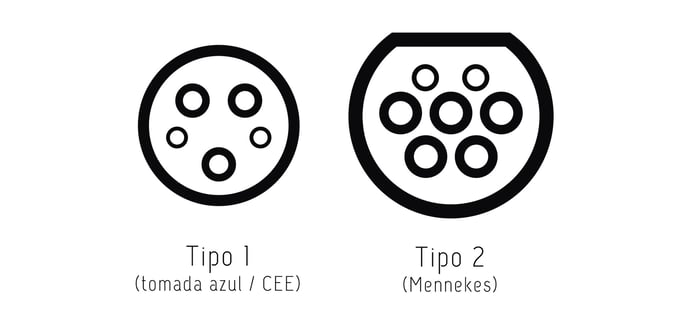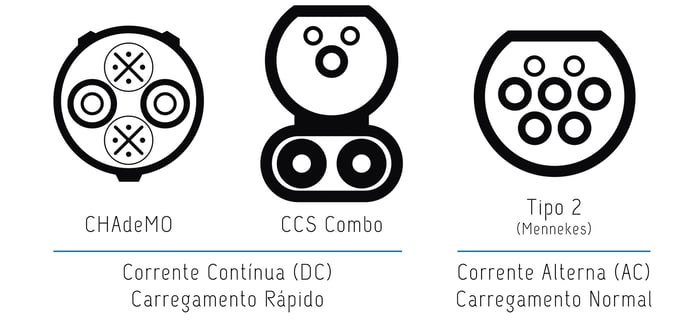How can I charge my electric vehicle?
Electric vehicles are an excellent option for TVDE drivers looking to increase their earnings.
One of the concerns that arises when considering the transition to an electric vehicle is the charging process. But don't worry, we're going to explain the different forms of electric charging so that you can make your experience as easy as possible.
There are two main forms of charging: home charging and public charging. We'll explain how each one works:
- Home charging (economical option):
Many electric vehicle drivers prefer to charge at night at home due to the safety, convenience and lower price of electricity tariffs. However, due to the slow charging speed (Example: 170kms = 10 hours, with a 3.45kWh household socket) it is not advisable to resort exclusively to this type of charging because, in TVDE activity, a high volume of kilometers is usually covered daily, so the charge obtained from a home charge may not be enough to complete a day's work.
To do this, you need to buy a home charging cable that is compatible with your vehicle and ensure that the power you have contracted from your electricity supplier is equal to or greater than the maximum power of the cable.
To increase your charging power, you can purchase a wallbox for higher power charging (up to 22 KWh), which has fixed costs associated with it.
- Public charging (best option):
At PCN (Normal Charging Station) and PCR (Fast Charging Station) charging stations, you can charge an average of 80% of your electric car's battery in half an hour, which is perfect for topping up your car during a break between journeys.
- PCN (Normal Charging Point):
In Portugal, you can access the network of Normal Charging Points (PCNs) via various mobile phone applications or online portals. On these platforms, you can easily check the type of plugs available, either type 1 or type 2/Mennekes, check the availability of charging points, and identify the operator responsible for each PCN. These sockets allow you to charge up to 22KWh (around 100 kilometers in 30 minutes). 
- PCR (Fast Charging Point):
There are also PCRs that allow charging in Alternating Current (AC) and Direct Current (DC), with 3 sockets available for this purpose, allowing charges of over 22KWh up to 120KWh (around 100kms in 5 minutes).

All the electric vehicles that Bluwalk has available for reservation are suitable for Normal Charging Stations and Fast Charging, namely through the type 2 socket (Mennekes).
Electric vehicles available for booking: BYD Atto 3, Opel Mokka-e, Citroeen e-C4 and Peugeot e-2008. Make your booking here.
Regardless of whether you charge your electric car at home or on the public highway, you should consider the following steps during each charging process.
- Switch off the engine.
- If you are charging at a public charging station, you must register or validate yourself at the charging station (via an app, with a payment card or via the QR code).
- Open the bonnet and connect the car to the charging station (with your own cable or that of the station).
- Start the charging process online or in the app.
- When the desired charge level is reached, you can stop charging. If the battery is fully charged, charging stops automatically.
- Now log off at the public charging station.
- Disconnect the charging station from the vehicle by first switching it off at the vehicle.
- Start the engine and you can continue your journey.
To carry out this type of charging, you need to have a charging card from the MOBI.E network. Bluwalk offers all TVDE drivers electric charging cards, in partnership with PRIO Eletric and miio, with no prepayment and no deposit. Order yours now here
Important notes on charging electric vehicles:
- The safety of charging is guaranteed by the charging station and battery safety systems so that it cannot cause damage or pose a danger to people who may be in the vicinity;
- During charging, the cable is fixed in the vehicle's socket and cannot be removed or damage the vehicle and/or the charging cable;
- Given the reliability of charging, the driver can leave the vehicle in complete safety, and can check the status of their charge remotely;
- There is no risk of a short circuit during charging in less favorable weather conditions (e.g. rain, thunderstorms);
- Optimize the time available for journeys by charging during lunch breaks, at the end of journeys and while offline on TVDE platforms.
Do you want to know how the value of your shipment is calculated? Check out this article
Want to know tips on how to save on your shipments? Check out this article
Having problems with your application? Report your situation here.
![Logo300dpi-3.png]](https://support.bluwalk.com/hs-fs/hubfs/Logo300dpi-3.png?height=50&name=Logo300dpi-3.png)